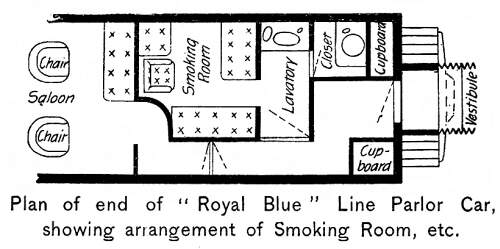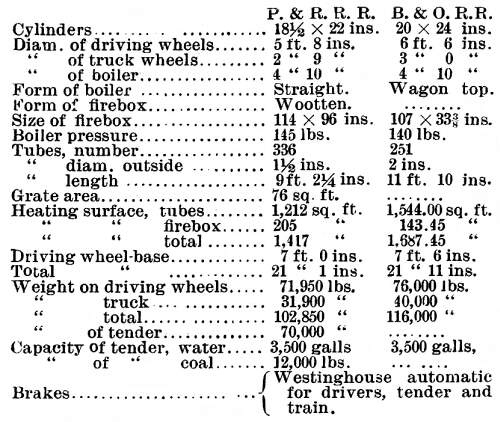FROM NEW YORK TO BALTIMORE
AND WASHINGTON BY RAIL.
Engineering News—February 27, 1892
In going to Baltimore to attend the meeting of the American
Institute of Mining Engineers, a report of which meeting is given
elsewhere in this issue, the train taken was the "Royal Blue"
express, leaving Jersey City at 11:42 a.m., and running over the
Central Railroad of New Jersey to Bound Brook, 31 miles; the Philadelphia
& Reading R. R. to Philadelphia, 60 miles; and the Baltimore
& Ohio R. R. to Baltimore, 96 miles, the total run being 187
miles. By the courtesy of Mr. J. H. Olhausen, General Superintendent
of the Central R. R. of New Jersey, the ride of 91 miles to Philadelphia
was made on the engine, which was a Philadelphia & Reading
R. R. eight-wheel engine with Wootten firebox, and the dimensions
of which are given below. The train consisted of two passenger
cars next the engine, weighing 70,000 lbs. each a parlor car weighing
74,000 lbs.; and a combined dining and baggage car weighing 80,000
lbs.; a total train load of 294,000 lbs. The dining saloon accommodates
24 persons, having three tables on each side. The parlor car is
finished in mahogany and upholstered in light grey or dove color.
The smoking room of this car is well arranged, being quite shut
off from the main part of the car, and also separated from the
lavatory and closet, as shown in the accompanying cut, the black
lines on which represent partitions. The ordinary cars have the
 Hale & Kilburn
seats, and each has a smoking room and lavatories. The cars are
all 65 ft. long, and are connected by vestibules. The cars for
all the Royal Blue trains were built by the Pullman Palace Car
Co., and are heated by steam and lighted by the Pintsch compressed
gas system. They are supposed to be painted the color known as
royal blue, but most of them are so dark as to appear almost black,
although some cars seen at the yards at Baltimore and Jersey City
had the bright blue color indicated by the name. Hale & Kilburn
seats, and each has a smoking room and lavatories. The cars are
all 65 ft. long, and are connected by vestibules. The cars for
all the Royal Blue trains were built by the Pullman Palace Car
Co., and are heated by steam and lighted by the Pintsch compressed
gas system. They are supposed to be painted the color known as
royal blue, but most of them are so dark as to appear almost black,
although some cars seen at the yards at Baltimore and Jersey City
had the bright blue color indicated by the name.
As already stated the train was hauled from Jersey City to
Philadelphia by a Philadelphia & Reading R. R. eight wheel
engine. Leaving Jersey City at 11:42 a.m., stops were made only
at Elizabeth, 11:58 a.m. and Wayne Junction, 1:20 p.m., the train
reaching Philadelphia (24th and Chestnut Sts. station) at 1:34
p.m., 1 minute late. If the train is over 4 minutes late, the
engine driver and fireman have to report and give an explanation.
The coal supply in the tender was not good, the greater proportion
being very dirty, and as a consequence, after passing Bound Brook
the fireman had hard work to keep up the pressure. The regular
working boiler pressure is 145 lbs. per sq. in., but beyond Bound
Brook it gradually fell to 100 and 95 lbs. There is no hood or
cab over the footplate of the tender, and the steam gage for the
fireman is placed in an awkward position on top of the firebox,
between the end of the firebox and the cab. Owing to the large
amount of grate area and the combustion chamber formed by the
bridge wall, there was very little smoke, and the long trail of
clean, white steam was most refreshing to see, as a change from
the usual dirty clouds of smoke and steam. The engine is very
steady on the track, and no unpleasant jerking or lurching motion
is felt in the cab. The tender, however, owing to its lighter
weight, is not very pleasant to ride on. Between Elizabeth and
Wayne Junction there is a straight ride of 74 miles, but in taking
water at the track tanks the train was slowed down to a much lower
rate of speed than is usual on other roads.
From Jersey City to Bound Brook, the Central R. R. of New Jersey
has four tracks, ballasted with broken stone. The two middle tracks
have heavy rails spliced by angle bars, 30 ins. long, with six
bolts. The two outer tracks have lighter rails spliced by angle
bars 24 ins. long with four bolts. The joints are broken and suspended.
As far as Bergen Point the line is protected by the automatic
electric block signal system described in our issue of March 29,1890.
From Bound Brook to Philadelphia the Philadelphia & Reading
R. R. has a double track road, with good track, well ballasted
with broken stone. The rails are laid with broken, suspended joints,
spliced by long angle bars and six bolts. Along this line are
peculiar revolving target signals mounted on towers resembling.
lighthouses, The signal consists of a vertical cylinder with three
radial wings, forming three wide targets, about 4ft. wide, painted
red, white and green respectively. A portion of the cylinder forms
the middle of each target and has openings fitted with glass of
corresponding colors for the night signals. The cylinder revolves
on its vertical axis, being turned by a man in the tower; the
cylinder and wings are about 6 ft. high.
At Philadelphia, a Baltimore & Ohio R. R. eight-wheel engine
was attached and took the train on to Baltimore, stopping only
at Wilmington, Del. The engines for this service are of great
size and power, and have driving wheels 6 ft. 6 ins. in diameter.
On this division the track is ballasted mainly with gravel, which
is covered over the middle of the ties. There is also some rock
ballast. The rails are laid with broken suspended joints, spliced
by angle bars and four bolts. The new standard track, and the
standard track signs, etc., of the Baltimore & Ohio R. R.,
have been described and illustrated in Engineering News, July
18, Oct. 31 and Nov. 7,1891. The cuts and fills are of a loose,
gravelly character, and are in places badly washed and worn by
the rain, necessitating frequent work in repairs. At Canton the
engine and four cars were run upon one of the tracks of a three-track
steam transfer or ferry boat, and carried across the harbor to
Locust Point, Baltimore, where the line runs through the streets
and ends in the Camden terminal station. Another engine is here
attached at what was the rear of the train to take the train on
to Washington. This ferry and dead end arrangement will be avoided
when the new Belt Railway (Eng. News, Dec. 12,19,1891, and Jan.
2,1892) and terminal station are completed. One of the old camel
back engines was seen in the yard at Baltimore. These engines
have eight wheels, all coupled, and the cab is perched on top
of the boiler, the firebox sloping down from the rear of the cab.
In bridge work the Baltimore & Ohio R. R. is using through
plate girders up to 102 ft. with double-track and 94 ft. with
single track. Riveted Warren girder deck spans are used up to
spans of 110 ft. The bridge floors are of ties 8 x 8 ins., spaced
12 ins. c. to c., giving a clear spacing of 4 ins.; the guard
timbers are 6 x 8 ins., 7 ft. apart. For bridge ties Georgia yellow
pine is being used, although rather more expensive than oak, as
it does not warp and split so much as oak. The ordinary ties are
of mountain oak, cut along the line of the road.
The trip to Washington was made over the Baltimore & Potomac
R. R. (Pennsylvania R. R. system), by the train leaving the Union
Station, Baltimore, at 8:27 a.m., and arriving at Washington,
43 miles, at 9:45 a.m. The return trip was by the train leaving
Washington at 5:40 p.m., and arriving at Baltimore at 6:40 p.m.,
making no stops. New rails are being laid on this division, spliced
by long angle bars and six bolts. The ballast is of gravel, except
at the track tanks, where broken stone is used. The line is equipped
with the Pennsylvania R. R. system of signals. Each car of this
train was heated by two stoves. The ordinary day cars were very
well appointed and very comfortable.
The return trip from Baltimore was made by the Royal Blue train
leaving the Camden station of the Baltimore & Ohio R. R. at
8:50 a.m. and making several stops. The train consisted of 6 cars:
1 express car, 1 baggage and smoking car, 2 day cars, 1 parlor
car, and 1 through sleeping car from southern points. It was hauled
to Philadelphia by one of the big eight-wheel engines above referred
to, the dimensions of which are given below. Philadelphia was
reached at 11:26 a.m., 16 mins. late, the run of 96 miles being
made in 2 h. 36 mins., and in one place three consecutive miles
were made in 55 sec. each. From Philadelphia to Jersey City the
train was hauled by a Philadelphia & Reading eight-wheel engine,
with Wootten firebox, as already described. On this run the fastest
mile noted was made in 53 secs., and several miles were made in
55 to 60 secs. each.
The following are the leading particulars of the two classes
of eight-wheel engines used on this trip:

Stories Page | Contents Page
|







